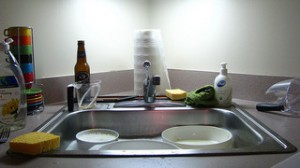This weekend while cleaning my dishes I noticed a troubling rotten-egg odor emanating from the drain, helpfully reminding me that it was not only time to run the garbage disposal but also to clean out the sink. “I think our colonies of sulfate reducers are coming along well,” I quipped to my roommate. But being the curious microbiologist that I am, I started to wonder, had anyone looked for sulfate reducers in kitchen sinks before?

A quick Google search yielded a study from 2012 in Boulder, Colorado. The study analyzed more than 80 surfaces from 4 residential kitchens using culture-independent methods characterize the microbial communities. Unfortunately for me the researchers were not much interested in the residential sulfur cycle, however their results were still quite interesting.
They did not have the resolution to detect individual pathogens but they did find that although the genera that contained well-known food pathogens were not dominant in any one community they were widely dispersed throughout the kitchen. They also found that floors and stove exhaust fans harbored the most diverse communities while metallic surfaces such as the sink and faucet had the least diverse communities.
In addition to studying the microbial content of communities themselves, the researchers analyzed the sources of those communities. They selected indicator taxa specific to three potential sources of bacteria, human hands, produce and faucet water and found that unsurprisingly human hands were one of the most important sources of bacteria across all surfaces while the water and produce contributed most to the areas in which they were used.
Although this study did not directly answer my original question, it does suggest some interesting directions for future projects. How, for example, does kitchen layout and design influence the microbial communities? Would it be possible to design a kitchen with a layout aimed to control the spread of pathogens? Could we design a refrigerator that was more “spoilage resistant?” And of course, most importantly, is it possible to prevent the odorous sulfate reducers from taking over my drain in the first place?
Hannah Holland-Moritz is an undergraduate in Jonathan Eisen’s lab studying the microbial communities of seagrass.